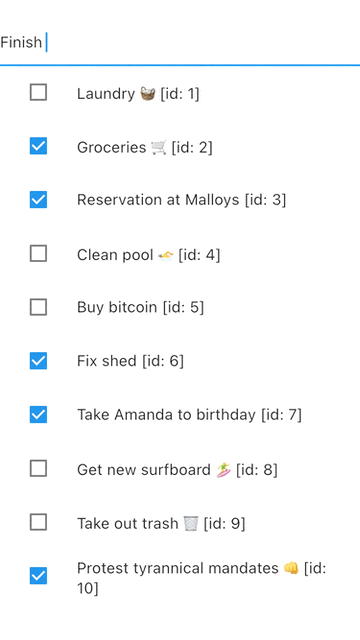First off let’s add just one line during the initialization. This will enable very helpful logging of our tasks repository!
// ...
child: ref.watch(repositoryInitializerProvider).when(
error: (error, _) => Text(error.toString()),
loading: () => const CircularProgressIndicator(),
data: (_) {
// enable verbose
ref.tasks.logLevel = 2;
return TasksScreen();
}
),
// ...
When we restart we notice the following:
flutter: 34:061 [watchAll/tasks@e20025] initializing
flutter: 34:100 [findAll/tasks@e2046b<e20025] requesting [HTTP GET] https://my-json-server.typicode.com/flutterdata/demo/tasks
flutter: 34:835 [findAll/tasks@e2046b<e20025] {1, 2, 3, 4, 5} (and 5 more) fetched from remote
Let’s add a TextField, turn the input into a new Task and immediately save it.
class TasksScreen extends HookConsumerWidget {
@override
Widget build(BuildContext context, WidgetRef ref) {
final _newTaskController = useTextEditingController();
final state = ref.tasks.watchAll();
if (state.isLoading) {
return CircularProgressIndicator();
}
return ListView(
children: [
TextField(
controller: _newTaskController,
onSubmitted: (value) async {
Task(title: value).save();
_newTaskController.clear();
},
),
for (final task in state.model!)
ListTile(
leading: Checkbox(
value: task.completed,
onChanged: (value) => task.toggleCompleted().save(),
),
title: Text('${task.title} [id: ${task.id}]'),
),
],
);
}
}
For this we need to import flutter_hooks!
Hot-reloading once again we see our TextField ready to create new tasks:

It was that easy!
You may have noticed that there was a flash with [id: null] (we didn’t supply any ID upon model creation), until the server responds with one (in this case 11) triggering an update.
Be aware that our dummy JSON backend does not actually save new resources so it will always respond with ID 11, causing a confusing situation if you keep adding tasks!
In the console:
flutter: 25:084 [watchAll/tasks@68f651] updated models
flutter: 25:087 [save/tasks@6bb411] requesting [HTTP POST] https://my-json-server.typicode.com/flutterdata/demo/tasks
flutter: 25:713 [save/tasks@6bb411] saved in local storage and remote
flutter: 25:714 [watchAll/tasks@68f651] updated models
NEXT: Reloading the list